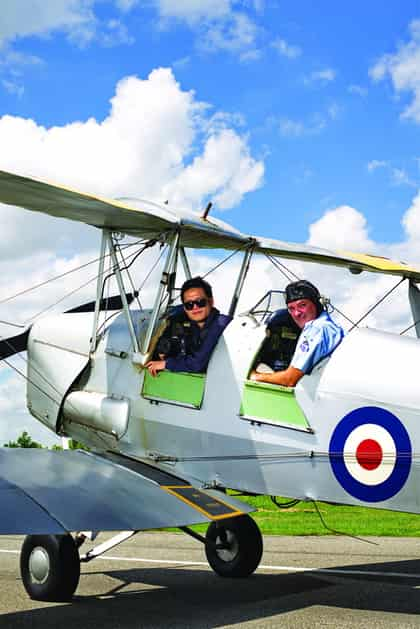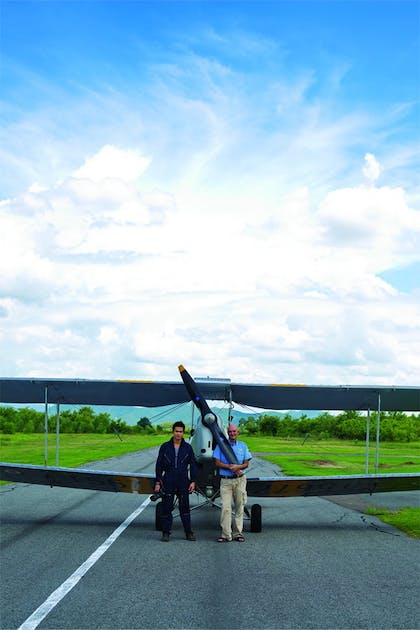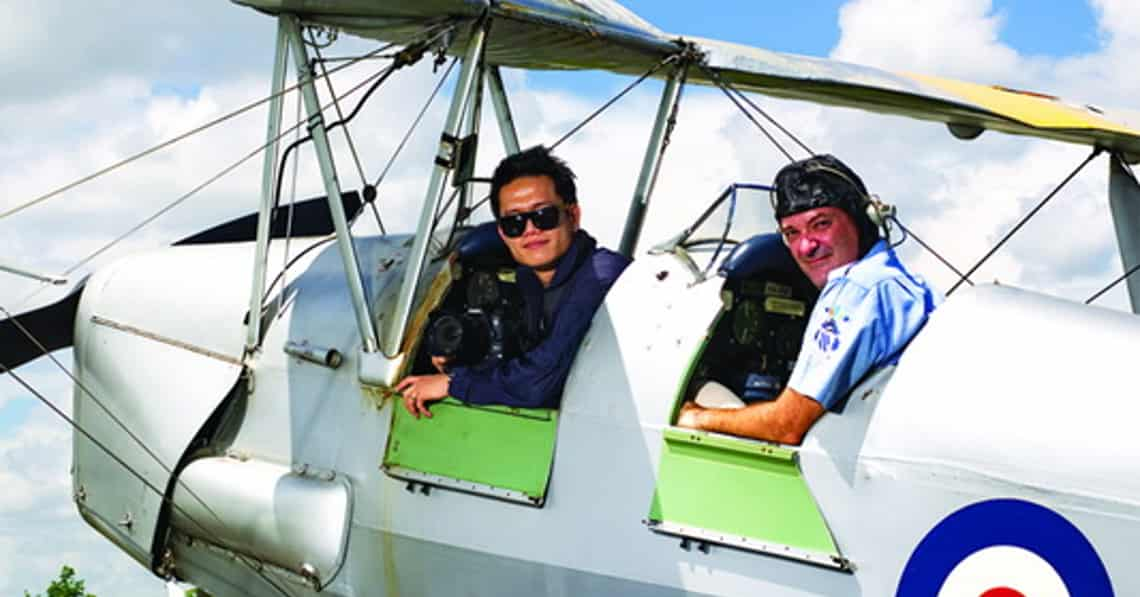
This British Thai couple have spent the past decade selflessly volunteering to help protect Thailand’s many endangered animals.
There are talkers and there are doers in this world; Tom Potisit and his partner Eduardo Loigorri stand firm in the latter group. Having met the couple on the rare occasion at various cocktail parties and wine tastings in Chiang Mai over the years, I knew that Ed flew planes and Tom was a photographer. But since neither of them had ever mentioned any job in particular, I assumed that they were yet another well-to-do couple enjoying Chiang Mai’s leisurely lifestyle.
Well, I was wrong.
This extraordinary couple have spent the past near-decade doing wonderful things for Thailand.
“I visited Thailand over a Christmas break for the first time in 1986,” said Ed, a retired Brit who has since made Chiang Mai his home. “I came back often on holiday but it wasn’t until the 2004 tsunami that I really became involved.”
Seeing the devastation first hand, Ed was compelled to help. With the help of his friends Ed founded a UK charity to raise funds to buy longtail boats to donate to those who had lost them to the tsunami. “We then became frustrated when we realised that we were unable to follow-up the usage of the boats properly; it was impractical driving up and down the coast looking for the fishermen, they are nomadic, following the fish for days, sometimes it took weeks to find one of our boats. So, when I came across an old Japanese air strip from the Second World War, I thought to myself how marvellous it would be if we had planes to do our follow-up instead of driving around.” Naively, imagining learning to fly would be a simple affair, Ed came to Chiang Mai and began to take flying lessons at the Chiang Mai Flying Club, where he met Tony Smallwood, the Chief Flying Instructor there and the two became firm friends.
By the time he qualified as a pilot some seven months later, the charity had all but finished its work, so the flying idea was never put to its original intent, but by then Ed was hooked on flying around Thailand.
“It was early 2007 by then and I had sold my financial software company in the UK and decided to retire here,” said Ed, who retired in his early forties. “I also met Tom at about this time.”
Once Ed received his pilot’s license and bought himself a 3 million baht canary-yellow Tecnam two-seater plane called Miss Dippy, he began to wonder what he could do with her. It was therefore fortuitous that Tony Smallwood, invited Ed to volunteer his time and his plane with the Wild Animal Rescue Foundation of Thailand (WARFT), who were, and still are, on the lookout for volunteers to help with their various animal conservation projects.
Tom, from Bangkok, had been working as an interior designer and had absolutely no interest in flying as he had a debilitating fear of flying. But Ed insisted. Being a couple and all, Ed wanted his boyfriend to enjoy his newfound hobby.
“I am a control freak,” smiled the handsome Tom. “I realised that if I was going to go up in the plane, I needed to do something. I couldn’t just sit there. So I began to take up photography. I taught myself. It really helped me to stop thinking of my fear, and over time it disappeared completely.”
And so it was. Ed and Tom took their first flight down to the south of Thailand to aid WARFT’s efforts in tracking the endangered dugong, a marine mammal related to the manatees found along Andaman Sea’s coasts from Ranong to Satun provinces, and off Trang coast.
“Miss Dippy was perfect for the task at hand,” beamed a proud Ed. “flying as low as 30 metres above sea level and at only 70 kilometres per hour _ we had also been approved to remove our plane doors _ we had great visibility of the sea below.”
It was a matter of much trial and many errors as the unschooled couple attempted to track, spot and record the migration of dugongs off Thailand’s shores with the help and mentoring of WARFT. They also worked closely with marine authorities and eventually realised that they needed ground support in order for their project to become more comprehensive.
“We are constantly
amazed that the
whales have adjusted
so well and can
cohabitate with all that
is going on in such a
busy shipping area”
Trang Province in particular has always had a close relationship with these sea mammals, with stories and legends featuring the dugong embedded in local culture. In conjunction with the marine authorities, the pair began to hold conversations with local fishermen, trying to convince them to not only stop hunting the dugong for meat, but also to aid them in conservation efforts by reporting sightings and liaising with the team. The Nation, in 2013, published an alarming report that seagrass meadows, on which the dugong feed, had shrunk sharply, from 12,173 square rai in 2006 to only 7,306 square rai in 2011, leading to the rapid reduction in dugong population.
“It was a steep learning curve,” explained Tom. “We had to learn how to work within the framework of the authorities, assisting them without stepping on their toes.

We then often had marine biologists and other scientists riding along with us and had to learn how to fly extremely accurate grid search patterns to scientifically asses the number and condition of the local dugong population.”
Seven years later, and with some serious man hours under their belt, the pair have helped develop very accurate flying and analysis techniques to spot and track the dugong.
Ed and Tom still spend around 50-60 hours per month between August and December working on dugong conservation. Having clocked over 2000 flight hours since 2006, their work has since expanded to track other sea creatures. From January to May they spot dolphins and sea turtles and from August to December they scour the Gulf of Thailand for byrde’s whales. The pair have recently returned to Chiang Mai from a survey of the whales. “We are constantly amazed that the whales have adjusted so well and can cohabitate with all that is going on in such a busy shipping area,” said Ed with his trademark smile. What started off as a hobby has now turned into an all-consuming passion which has changed both of their lives. “We thought we would come to live in Chiang Mai and enjoy a quiet life. It’s now a full time job!” they laughed.
With Miss Dippy so overworked, the couple decided that it was time for a new plane. “We flew to the US to buy the plane and thought that it would be fun to fly back slowly, visiting many places we had always dreamt of going,” said Tom.
It was 2008, Thailand was in political turmoil and HM the King’s health was ailing. Everywhere they went in the US they encountered Thai people who asked about HM and wanted to express their love and concern.
“I was standing in a post office in Florida one day,” said Tom, of what would become a life-changing moment. “There was a little boy there who was sending his father, whom he hadn’t seen in a long while, a postcard. So I had this idea that it would be a nice gesture to invite the Thais we met on our travels to write a postcard which we would deliver to Siriraj Hospital where His Majesty was convalescing.”
And so it began, the pair flew Malee, their brand new Piper Jetprop, home with 23 stops in 19 countries (Ed refuses to fly for more than four hours at a stretch). The aim was to collect 81 post cards to celebrate the King’s 81st birthday during this two and a half week journey. Due to social media the entire venture started to snowball. Thai people from country to country would tell each other of the duo’s imminent arrival, handing over their postcards. Upon their return, all postcards were lovingly made into a collage, printed out, framed and presented to the Royal Household.
“It was a fun thing to do, but we didn’t think too much about it,” said Ed who soon returned to his task of dugong spotting, something he dedicated the next two years towards. “But we kept thinking about how much fun it all had been and so we decided to do it all over again!”
This time, in 2011, Tom and Ed invited Chiang Mai’s artists to paint and donate postcards to take on their trip, now grandly titled: The Global Expedition for the World’s Greatest King. The aim was to visit 14 countries ending in the United Kingdom (even stopping off in Bhutan, featured in this month’s Citylife) over a period of four and a half months. They were taking their time on this trip.
“It was a logistical nightmare,” said Tom, who, being a Thai citizen, struggled to get visas, while Ed, in charge of flight permits and all things aviation, nodded in agreement. “The only way to stay sane was to divvy up the job. Ed was in charge of everything airborne, while I was in charge of all things on the ground.” It took three months to plan but they were finally ready to go.
By this time, understanding the powers of social network, they were more prepared…but in spite of this they were still overwhelmed by the response they received everywhere they went. In Germany, the Thai students’ association had spread the word far and wide and over 600 postcards were delivered to a sobbing Tom, who was more than touched by the gesture. In Switzerland they were introduced to the son of the King’s guardian when he used to live in Switzerland and together they visited the Thai sala erected in 2007 to commemorated His Majesty’s 60th year on the throne, which sits in a park in Lausanne overlooking the stunning Lake Léman. In Greece’s Santorini they found themselves at a dead end with no known Thai residents or Thai restaurants. So, hopping onto a rented quad bike, they decided to check out the island’s only ‘Asian’ restaurant where the helpful manager finally managed to point them to the only Thai resident on the island. It turns out that this 65 year old woman had not been home for over 20 years, having faced bankruptcy and was unable to afford to pay her taxes to the Greek government. She is still working off her debt and was so excited to meet Tom, a fellow citizen, that she was inconsolable. It took her a while to stop crying before she could write her personal postcard to her King. In Chittagong they came across some Thai masseuse in the hotel spa…and so it went. Thais from all walks of life in 14 countries wrote and handed over a total of 1,200 postcards for the intrepid aviators to deliver to His Majesty the King.
Tom and Ed were unprepared for the brouhaha which greeted them upon their return to Chiang Mai. Word had spread and people were interested, and the runway was packed with well-wishers as well as the media.
“The gibbon
rehabilitation project
takes in sick gibbons
and nurtures them in
order to introduce
them into the wild”
Before they had a chance to visit Siriraj Hospital they were contacted by the Royal Household who wanted to organise an audience for Tom and Ed with the King. Unfortunately His health was not great and so they met with Princess Sirindhorn instead.
“We were so nervous,” said Tom who had been practicing his curtsey for days before the meeting. “We had made three copies of a really special book containing all the postcards, and my photo journal of our travels; one was for His Majesty, one for the princess and one was for our special collection. It was an incredible day and I felt such joy to have been able to do this for my King.”
Since then, Tom and Ed have been contacted by numerous corporations to produce similar type adventure style books, Tom’s photography becoming more coveted with each project. But as Tom said, “I am happy to help, and through all of this we never took anyone’s money, it has always been at our own cost, but I am not going to do it so someone can sell beers.”
One idea they are tinkering with is to travel the world _ again, at their own expense _ to photograph places and projects which have been affected by His Majesty King Bhumibol. “In Afghanistan, for instance, they have adopted the model of our Royal Projects,” gushed Tom about his new idea. “In many African countries, as well as in Queensland in Australia, they use the internationally patented technology developed by the King for rainmaking…we are still thinking about it.”
In the meanwhile, they have not abandoned their dugong…or turtles, or whales, or dolphins. Not only that, their friend Tony Smallwood who recently passed away, had a deathbed wish to set up a gibbon sanctuary in Chiang Mai’s Mae On. He had laid down the groundwork and had already scouted 30,000 rai of National Forest donated by the Queen Sirikit Foundation to the local community at Ban Jampee now approved as a release area for gibbons. The gibbon rehabilitation project takes in sick gibbons and nurtures them in order to re-introduce them back into the wild. The first gibbon pair were flown up from Phuket, by Ed, in July. Ed and Tom also have spent many hours flying over the donated land to see if there was enough tree canopies and food to determine whether it would be an acceptable habitat. There are currently 30 gibbons waiting in the Phuket departure lounge for transfer.
“It is not easy,” says Ed. “We discovered that gibbons are very tactile. So we had to make sure that they were flown in pairs and modify their cages so that they could touch each other during flight. A vet also had to be on board for the flight as we do not sedate the animals. After arrival in Chiang Mai, it takes at least two months to monitor them and make sure they are ready for the wild. We have staff to track them every day for the first two years and the first year we provide them food supplement, in total it is a five year commitment,” explained Ed, who didn’t look at all perturbed at the extra work.
“The exciting thing is how much support we have received,” explains Tom. “My media and photography friends are now interested in getting involved and doing photography projects to raise awareness about environmental threats and concerns. Ed’s amateur pilot friends, both Thai and foreign, are also donating their time, some even modifying their planes, to help out with his works in the south.”
The incredible hard work and dedication of not only time but costs towards Thailand’s conservation of its wild animals by this extraordinary couple is inspirational. We will keep you posted of their future projects, of which, no doubt, there will be many.
You can follow them at www.theflyingscouts.com
